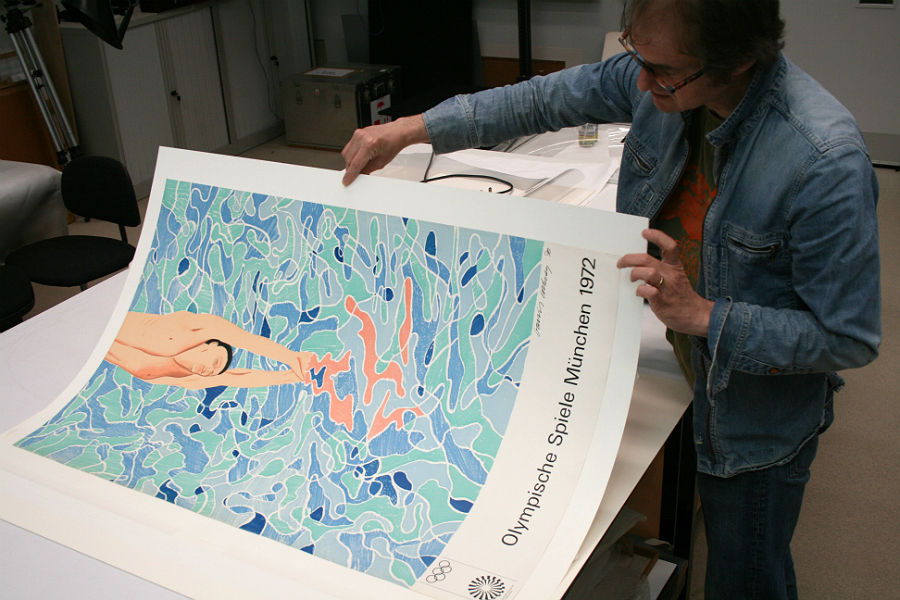1972 Olympic posters go on display

Jaded by the already overwhelming pre-Olympics coverage on TV? Get down to the Walker where a very special run of prints tell their own story of the social impact of the games…
Try to push aside for a moment any mounting fatigue relating to this year’s London Games and the fall-out from the much derided logo, and focus instead on the cultural and social footprint the Olympics tradition has left. Poignant and significant moments aren’t hard to come by: Jesse Owens winning four Olympic gold medals under the noses of a visibly devastated Hitler and his Nazi regime cronies in Berlin in 1936. The Black Power salute of Tommie Smith and John Carlos in Mexico City’s 1968 Olympics.
There are darker memories, too. The 1972 Summer Olympics was overshadowed and rendered insignificant by what would come to be known as the Munich disaster, when Palestinian group Black September took 11 members of the Israeli team hostage in the Olympic Village apartments. Two hostages were murdered in the first moments of a siege, and all other hostages were killed during a botched rescue attempt.
This tragedy is brought back into focus at the Walker Art Gallery this week, if somewhat indirectly. Eighteen official lithographic prints produced for the ’72 Munich Olympics, all from the Walker’s own archive, feature the work of celebrated artists including David Hockney, Allen Jones, Oskar Kokoshka, Ron Kitaj and Eduardo Chillida.
Ironically, this Olympics had aimed to promote a positive image; international sporting endeavour and the modern German nation in tandem. The official motto of the event was The Happy Games. Part of this hoped for positive image included recognising the games’ cultural potential, the Munich organising committee commissioning a set of posters (designed by a clutch of the top artists of the day), as part of an effort in ‘relating artistic activity to the Olympic Games’ – something that succeeding games have imitated ever since.
Ann Bukantas, Head of Fine Art at the Walker, said: “What’s really incredible is the range of the artists commissioned to do them; artists that are now household names like David Hockney and Allen Jones, but you’ve also got some really cutting edge European artists like Victor Vasarely and Otmar Alt who were really pushing the boundaries and have subsequently become very influential. The diversity of styles and use of colour is just spectacular.”
The gallery consulted pop artist Allen Jones for the exhibition (35 at the time of the Munich commission), whose design depicts two pairs of legs running at each other, head to head in competition. The artist wanted to embody the leading running shoe companies of the era, Puma and Adidas. Originally one company run by two brothers, the Dassler siblings had a huge family feud which resulted in splitting the brand into competitive businesses and the pair becoming rivals.
David Hockney’s poster (pictured above) is great example of his graphic design work. Showing an athletic figure diving into a shimmering pool of crayon abstract shapes, the artwork is reminiscent of his John Moores Prize winning painting, Peter Getting Out Of Nick’s Pool (1967), also on display at the Walker.
“The other really significant thing for us as a gallery is that we have got a major collection of works on paper, and we are actively trying to get more of that collection on view. We have a lot of modern prints from 1960s-80s, and we just want to get them out on show more so people can experience the full range of our collection. We’re working towards a project where we are digitalising our works on paper collection, too, to make it fully accessible so it’s part of that move,” added Bukantas.
The exhibition was researched by voluntary curator Emma Sumner who will lead a series of talks on the show in August. The events will further illuminate the vision of the games in ‘72 and their legacy, the key artists and their work, and the tragedy that shadowed it all.
Exhibition opens tomorrow Saturday 14 July 2012
Go along to one of the free talks on this exhibition on Friday 3 August 11am and 1pm, and on Tuesday 7 August 11am and 1pm.





